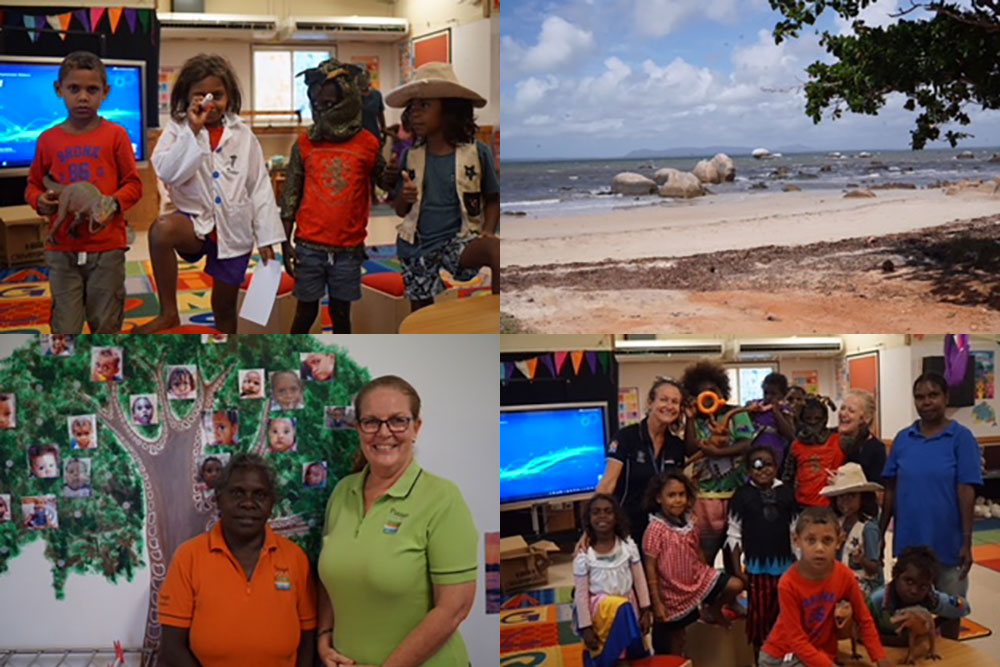A pilot solar project in a small Aboriginal community in far north Queensland could hold the key to cleaner and more reliable power supply for isolated Indigenous communities throughout Australia and the Pacific.
The township of Lockhart River on Cape York Peninsula is nestled in bushland, 800 kilometres north of Cairns, surrounded by pristine beaches and rainforest.
It’s idyllic, but incredibly remote. So much so it’s not even on the national power grid.
So Lockhart River relies on expensive and dirty diesel fuel to keep the lights on, and power the town’s businesses and homes.
But it’s hoped a solar trial instigated by Griffith University Professor of Economics Paul Simshauser could change that.
“We ended up installing about 200kW of rooftop solar around various rooftops,” he said.
“It’s a community project so all of the households benefit from it.
“I’m not completely sure but I wouldn’t mind betting this is one of the highest levels of solar in Australia.”
When Professor Simshauser was Director General of Queensland’s Power and Water Supply Department, he made a connection with the Lockhart River community through the government’s Champions Program, where the Director-General of each department is given an Aboriginal community to grow partnerships with.
Professor Simshauser says the ramifications for this project, if successful, will go far further than Lockhart River.
“There’s a couple of implications – the first thing is the idea of doing community solar is that each of the households wouldbenefit each year from the solar output; they’d get a rebate on their electricity bills, because you’re avoiding burning expensive and not-so-healthy diesel fuels,” he said.
“But I think the bigger implication is that we have 30 remote communities in Queensland and a whole bunch in the Pacific and across northern Australia so clearly if we can break the mould on how to really radically increase the amount of solar in these communities, that will be wonderful for those communities in terms of their power, reliability and reducing the logistics of bringing in and burning diesel fuels.”
Listen to the full Remarkable Tales podcast episode below.
Five Aboriginal languages were spoken by the people at Lockhart River, who have shown connection to the land for thousands of years.
It was also the home for around 5000 troops during World War II, with many historical relics still intact for tourists to visit.
Lockhart River overlooks the World Heritage-listed Great Barrier Reef, with bird watching, bush walking, and fishing to entice visitors.
ButLockhart River Mayor Wayne Butcher saysthe lack of reliable power supply has been a big hurdle to expansion for the community to take advantage of some of these tourism assets.
“We’refortunate to have a governmentchampion such as Paul who can think outside the square I guess,” Mr Butcher said.
“It’s good to be able to talk to Paul and to create an idea into a reality in such a short period of time.
“The cost of living up here, we’re not far from the equator, we’ve got plenty of sunshine, so common sense tells us we should be looking at alternative energy.
“I think the microscope is on Lockhart to see how the program goes here in the first 12 months, and I can see the benefits of it being rolled out to the other Indigenous shires on Cape York Peninsula.”
The excitement at the prospective benefits from the solar project has spread throughout the Lockhart River community.
Lockhart River State SchoolPrincipal Siobhan Jackson has been in Lockhart River for five years, and says the trial is exciting for the town.
“We’re trialling some sustainable energy in Lockhart River, which is fantastic, andit’s great for the kids to learn from that. They might be in a place where they don’t even get to see a solar panel but we’ve got lots and lots of them, so they’re very aware of that,” Ms Jackson said.
“Moving away from those dirty sorts of energy sources.”
As well as being extremely remote, the Lockhart River community faces many complex challenges.
Life expectancy is up to 20 years less than the Australian average, and income is far less than the average wage; however, groceries – including fresh food – are much more expensive. The unemployment rate is three times the national average.
In response to this, the community decided to put the focus on new technologies such as solar, to provide more options for the youngest members of the community and give them hope for the future of Lockhart River.
The Puuya Foundation is an important part of that.
It was developed by the community for all children under five years old, the most critical time for a child’s development.
The Kuunchi Kakana Centre is community-led and run, and is the heart of the Montessori model that the community decided to pursue for their children.
Denise Hagan is the coordinator of the Puuya Foundation, and works closely with Indigenous teachers to ensure the community’s wishes are being met.
“It’s life-changing work that they’re doing, they’re teaching parents to get involved in their children’s education and children are really benefiting from that,” Ms Hagan said.
“Research we’ve done shows that from teachers’ perspectives, parents’ perspectives, the children’s perspective, the children are much more prepared for school; they’ve got theheadstart they need.”
Professor Simshauser has organised a special auction of Aboriginal art from the Lockhart River art gang, to raise money for the Puuya Foundation,at the Brisbane Club onJune 19.
Denise Hagan says the money raised from last year’s art auction was invaluable to keep their important work with small children at the Puuya Foundation going.
“We do get some funding from the government but it’s not enough,” she said.
“We have a very big commitment here to training local people so that this centre is locally run and the costs of travel make everything we do here very expensive but it’s life-changing work, and work that wasn’t happening before.”
